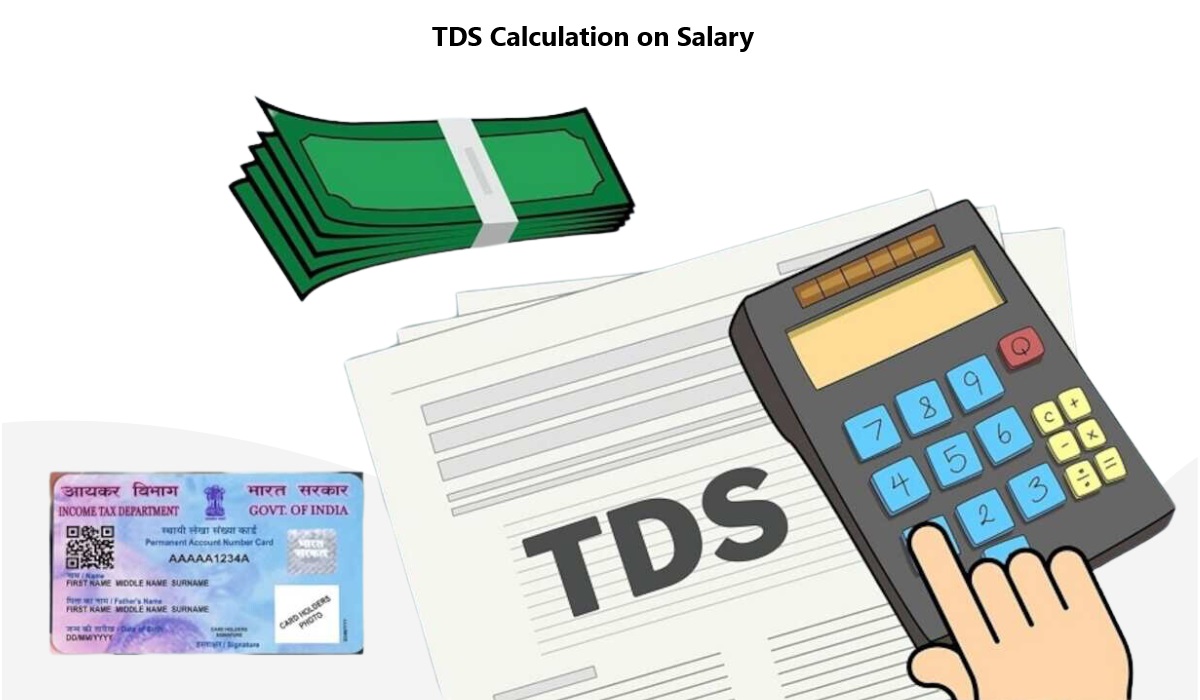TDS Calculation on Salary: In today’s fast-paced world, individuals and businesses alike need to understand various financial processes. One such crucial process is calculating TDS (Tax Deducted at Source) on salary. This system ensures taxes are collected at the source of income, which, in the case of salary, is the employer. By doing so, employees can avoid paying large sums at the end of the year and ensure timely fulfillment of their tax obligations.
This article will explain why TDS is essential, how employers calculate it on salary, and explore various exemptions and deductions. Let’s dive deeper into this essential aspect of personal finance.
What is TDS?
TDS (Tax Deducted at Source) refers to the tax that an employer deducts from an employee’s salary before paying it. The employer then deposits the deducted amount with the government. The amount deducted depends on the income tax slabs set by the Income Tax Department of India. This tax acts as a prepayment of the employee’s income tax and ensures that employees pay their taxes throughout the year in manageable amounts.
TDS helps in reducing the tax burden at the end of the financial year, allowing employees to fulfill their tax responsibilities gradually.
TDS Calculation on Salary
Calculating TDS on salary involves several steps, including determining the total salary, applying tax deductions, and then calculating the tax based on income tax slabs. Here’s how you can calculate it step by step:
1. Determine the Total Salary Income
The first step involves calculating the total income, which includes:
- Basic Salary: The fixed amount that an employee receives regularly.
- House Rent Allowance (HRA): An allowance given to employees for renting accommodation.
- Special Allowances: These could include allowances like travel, medical, and more.
- Bonus and Incentives: Any extra payments the employee receives, typically related to performance.
Once you determine the total income, you can proceed to apply deductions.
2. Apply Taxable Salary Deductions
Next, apply the deductions available under various sections of the Income Tax Act. Some of the common deductions are:
- Section 80C: Deductions on investments in PPF, ELSS, NSC, etc. The maximum eligible deduction is ₹1.5 lakh.
- Section 80D: Deductions on medical insurance premiums.
- Section 10(13A): Exemption for House Rent Allowance (HRA) based on rent paid.
- Section 24(b): Deductions on home loan interest, if applicable.
These deductions lower your taxable income, which in turn reduces the TDS amount deducted from your salary.
3. Determine the Applicable Tax Slab
The income tax slabs vary depending on an individual’s total taxable income. For the financial year 2024-25, the slabs are as follows:
- For individuals below 60 years:
- Up to ₹2.5 lakh: No tax
- ₹2.5 lakh to ₹5 lakh: 5%
- ₹5 lakh to ₹10 lakh: 20%
- Above ₹10 lakh: 30%
- For senior citizens (aged 60 years and above but below 80):
- Up to ₹3 lakh: No tax
- ₹3 lakh to ₹5 lakh: 5%
- ₹5 lakh to ₹10 lakh: 20%
- Above ₹10 lakh: 30%
- For super senior citizens (aged 80 years and above):
- Up to ₹5 lakh: No tax
- ₹5 lakh to ₹10 lakh: 20%
- Above ₹10 lakh: 30%
4. Calculate the TDS
After applying the appropriate tax slabs, you can calculate the TDS based on your taxable salary. For instance, if the taxable salary of an employee is ₹6,00,000 after deductions, the TDS calculation would be:
- ₹2,50,000: No tax
- ₹2,50,000 (₹2.5 lakh to ₹5 lakh): Taxable at 5% = ₹12,500
- ₹1,00,000 (₹5 lakh to ₹6 lakh): Taxable at 20% = ₹20,000
So, the total tax = ₹12,500 + ₹20,000 = ₹32,500.
The employer would then deduct this amount from the employee’s salary every month and pay it to the government.
5. Rebate Under Section 87A
Individuals with taxable income under ₹5 lakh can avail of a rebate under Section 87A. This rebate allows a reduction of up to ₹12,500 on the total tax liability, further lowering the TDS amount.
6. Other Deductions
Employers also deduct other amounts such as:
- Provident Fund (PF): A portion of the salary that employees contribute to their retirement savings.
- Professional Tax: A state-level tax deducted based on salary.
- Insurance Premiums: If employees contribute to any insurance schemes, the amount may be deducted before calculating the TDS.
These deductions can reduce the taxable income, leading to a lower TDS calculation.
Common Exemptions in TDS Calculation on Salary
Several exemptions reduce the TDS amount on salary. Some of the most common exemptions include:
- House Rent Allowance (HRA): Employees living in rented accommodation can claim HRA exemptions, which depend on their salary, the rent paid, and the city of residence.
- Leave Travel Allowance (LTA): Employees can claim exemptions for domestic travel expenses, as long as they meet the conditions laid out by the Income Tax Act.
- Gratuity: A portion of the gratuity amount may be exempt from taxation, depending on years of service and other factors.
Importance of TDS Calculation on Salary

TDS Calculation on Salary
The importance of TDS calculation cannot be overstated. It not only helps ensure timely tax payments but also prevents employees from having to pay large sums of tax at the end of the year. By deducting TDS at regular intervals, employers assist employees in managing their finances better. Furthermore, it ensures compliance with tax regulations and reduces the risk of tax evasion.
TDS also simplifies the tax filing process for employees since they have already made payments towards their tax liabilities throughout the year. This system promotes transparency and helps track tax payments efficiently.
Key Takeaways
- TDS is deducted by the employer before paying the salary to the employee.
- Tax slabs and available exemptions significantly influence the TDS amount.
- Deductions like Section 80C and Section 80D can reduce taxable income, lowering the TDS.
- Section 87A provides a rebate for those with taxable incomes under ₹5 lakh.
- HRA, LTA, and gratuity exemptions also contribute to reducing the TDS.
Conclusion
To conclude, TDS calculation on salary is an essential process for both employers and employees. It ensures that taxes are deducted regularly and on time, preventing large tax payments at the end of the financial year. By understanding the TDS calculation process, exemptions, and deductions, employees can manage their finances better and avoid any last-minute tax burdens. Always consult a tax professional to ensure accurate calculations and proper compliance.
FAQ
- What is TDS on salary? TDS refers to the tax deducted at the source of salary by the employer as per the income tax rules.
- How is TDS calculated on salary? TDS is calculated based on the employee’s taxable income, deductions, and applicable tax slabs.
- Can I claim a rebate on my salary income? Yes, if your taxable income is less than ₹5 lakh, you can claim a rebate under Section 87A.
- What exemptions can reduce TDS on salary? HRA, LTA, and gratuity are some of the exemptions available for reducing TDS.
- What if TDS is deducted incorrectly? If the TDS is deducted incorrectly, you can request a correction through your employer or the Income Tax Department.
- Is TDS applicable to all employees? Yes, TDS applies to employees whose taxable salary exceeds the minimum exemption limit.
- Can TDS be refunded? If the TDS is deducted in excess, you can claim a refund during the filing of your income tax return.
- Is TDS the final tax liability? No, TDS is only an advance payment. You may need to pay additional tax based on your final taxable income.
- How often is TDS deducted? TDS is deducted monthly, and the employer remits the deducted amount to the government.
- Do I need to file an income tax return if TDS is deducted from my salary? Yes, you need to file an income tax return to claim any refunds and ensure proper tax computation.
Disclaimer
The information provided in this article is for informational purposes only. For personalized advice, consult a qualified tax professional.











Leave a Reply